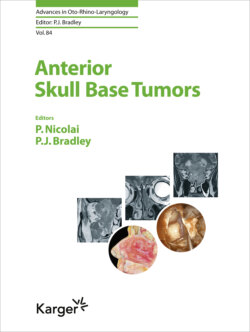Читать книгу Anterior Skull Base Tumors - Группа авторов - Страница 78
На сайте Литреса книга снята с продажи.
A Checklist Approach to Reporting Lesions Involving the ASB
ОглавлениеWhen reporting the local extent of a lesion involving the ASB, the radiologist has to be aware of a series of critical anatomical structures, the invasion of which impacts treatment planning [4, 29]. Hence, a checklist approach should be adopted to standardize the report and reduce the risk of overlooking crucial findings.
Fig. 6. Intestinal-type adenocarcinoma. MR in three coronal planes obtained with a TSE T2 (a) and TSE T1 sequences before (b) and after (c) contrast agent administration. The tumor (T) fills the left nasal fossa and extends along the septum to reach the olfactory fissure, where it displaces the left superior turbinate (dotted arrow). The neoplasm shows high and non-homogeneous signal intensity on T2 (a), due to large mucinous components. These parts appear hypointense on plain T1 (b), while the postcontrast enhancement is rather heterogeneous (c). The tumor reaches the nasal floor (black arrows). A mucocele (m) arises from an ethmoid cell. It is characterized by a typical pattern of signals: hypointensity on T2, mild hyperintensity on T1 – indicating the presence of dehydrated impacted mucus – and no enhancement. The mucocele remodels the lamina papyracea and the fovea ethmoidalis (white arrow). st, right superior turbinate; ob, olfactory bulbs; ms, blocked left maxillary sinus.
The first step consists of separating the tumor from the signal of the retained mucus or the inflamed thickened mucosa in a blocked sinus. On plain CT the discrimination is less clear than on T2W MRI sequences, where the mucus shows a greater signal than most tumors. However, if large mucinous components characterize the tumor, as in intestinal-type adenocarcinoma, the differentiation from retained secretions or mucoceles may be difficult. Enhancement of solid parts of the tumor after contrast agent administration improves discrimination on CT and MRI. An additional advantage of MRI is that long-standing blocked secretion, as well as many mucoceles, exhibit a recognizable increased signal on T1W sequences, due to the increase in protein content (Fig. 6).
The second step is mapping tumor spread to investigate either the accessibility for TES, or the need for an open access. Depending on the extent of the tumor, TES can be exclusively endonasal or combined with a transcranial approach (CER) [5, 30]. Purely endonasal approaches are graded into unilateral (i.e., the resection extends sagittally from the posterior wall of the frontal sinus to the planum sphenoidale and coronally from the nasal septum to the lamina papyracea) or bilateral (i.e. the resection extends from one lamina papyracea to the opposite one). TES may be extended to include the dura of the ASB from the posterior wall of the frontal sinus back to the planum sphenoidale (endoscopic resection with transnasal craniectomy).
